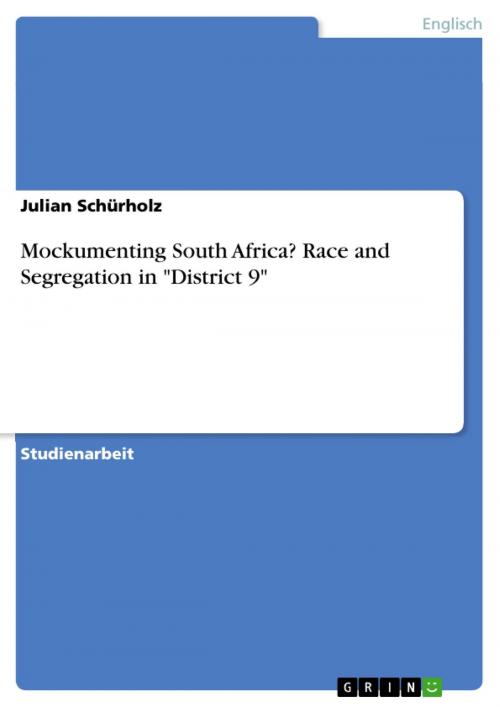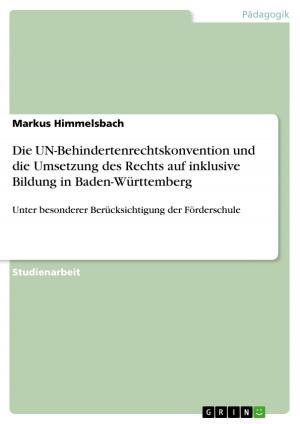Mockumenting South Africa? Race and Segregation in 'District 9'
Nonfiction, Entertainment, Drama, Anthologies| Author: | Julian Schürholz | ISBN: | 9783640674985 |
| Publisher: | GRIN Verlag | Publication: | August 3, 2010 |
| Imprint: | GRIN Verlag | Language: | German |
| Author: | Julian Schürholz |
| ISBN: | 9783640674985 |
| Publisher: | GRIN Verlag |
| Publication: | August 3, 2010 |
| Imprint: | GRIN Verlag |
| Language: | German |
Studienarbeit aus dem Jahr 2010 im Fachbereich Amerikanistik - Sonstiges, Technische Universität Carolo-Wilhelmina zu Braunschweig (Englisches Seminar der TU Braunschweig), Veranstaltung: Introduction to Film: History, Theory, Analysis, Sprache: Deutsch, Abstract: 'District 9', one of the movie blockbusters of 2009, was directed and co-written by Neill Blomkamp, produced by Peter Jackson, and is nominated for four Oscars (cf. IMDb). It is a documentary-style fiction movie whose story revolves around a (para-)military relocation operation of over one million aliens, who have been living in a hermetically sealed off slum near the South African city of Johannesburg since the early 1980s. Tensions arose between the human and the alien population, ultimately leading to the relocation operation. The leader of the operation is Wikus van de Merwe, a naïve white-collar worker, who, in the course of the movie, accidentally infects himself with a virus that slowly turns him into an alien. Considering the real-world history of the movie's setting, thrilling similarities between events during the time of the South African Apartheid regime and the story of District 9 catch one's eye. The most blatant one is the forced relocation of around 60,000 people from the Sixth Municipal District of Cape Town in the course of a large-scale government program to segregate South African society by assigning a certain area of the country exclusively to one specific ethnic group. Moreover, the major 'player' in the story of District 9 is the private security firm MNU, which also finds its counterpart in recent South African history. Through large parts of the movie, District 9 pretends to be a patchwork of media edited into a documentary. This paper will deal with the question of whether 'District 9' is a mockumentary about real-life South Africa, especially Cape Town's District Six. The first part of this paper will focus on content and give a rough outline of the most important historic events in South Africa and specifically in District Six. Then, the parallels to these events as depicted in District will be put on display. Secondly, this paper will turn to examining form and display typical characteristics of mockumentaries. This will necessarily involve the examination of what defines documentary as a genre. As a next step, this paper will try to find examples of these characteristics in District 9. Eventually, this paper will answer the question of whether or not District 9 is a mockumentary about South Africa and District 6.
Studienarbeit aus dem Jahr 2010 im Fachbereich Amerikanistik - Sonstiges, Technische Universität Carolo-Wilhelmina zu Braunschweig (Englisches Seminar der TU Braunschweig), Veranstaltung: Introduction to Film: History, Theory, Analysis, Sprache: Deutsch, Abstract: 'District 9', one of the movie blockbusters of 2009, was directed and co-written by Neill Blomkamp, produced by Peter Jackson, and is nominated for four Oscars (cf. IMDb). It is a documentary-style fiction movie whose story revolves around a (para-)military relocation operation of over one million aliens, who have been living in a hermetically sealed off slum near the South African city of Johannesburg since the early 1980s. Tensions arose between the human and the alien population, ultimately leading to the relocation operation. The leader of the operation is Wikus van de Merwe, a naïve white-collar worker, who, in the course of the movie, accidentally infects himself with a virus that slowly turns him into an alien. Considering the real-world history of the movie's setting, thrilling similarities between events during the time of the South African Apartheid regime and the story of District 9 catch one's eye. The most blatant one is the forced relocation of around 60,000 people from the Sixth Municipal District of Cape Town in the course of a large-scale government program to segregate South African society by assigning a certain area of the country exclusively to one specific ethnic group. Moreover, the major 'player' in the story of District 9 is the private security firm MNU, which also finds its counterpart in recent South African history. Through large parts of the movie, District 9 pretends to be a patchwork of media edited into a documentary. This paper will deal with the question of whether 'District 9' is a mockumentary about real-life South Africa, especially Cape Town's District Six. The first part of this paper will focus on content and give a rough outline of the most important historic events in South Africa and specifically in District Six. Then, the parallels to these events as depicted in District will be put on display. Secondly, this paper will turn to examining form and display typical characteristics of mockumentaries. This will necessarily involve the examination of what defines documentary as a genre. As a next step, this paper will try to find examples of these characteristics in District 9. Eventually, this paper will answer the question of whether or not District 9 is a mockumentary about South Africa and District 6.















